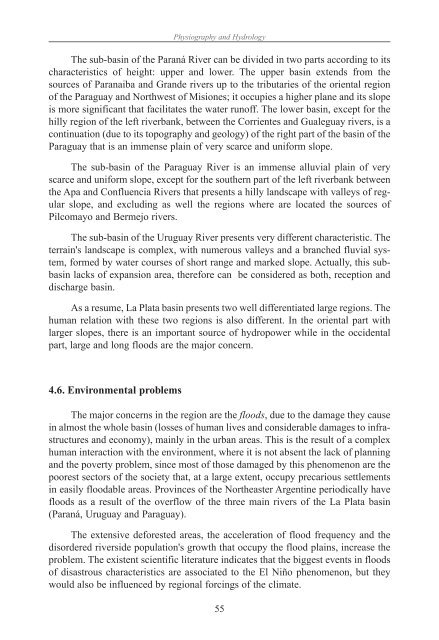chapter - Atmospheric and Oceanic Science
chapter - Atmospheric and Oceanic Science
chapter - Atmospheric and Oceanic Science
Create successful ePaper yourself
Turn your PDF publications into a flip-book with our unique Google optimized e-Paper software.
The sub-basin of the Paraná River can be divided in two parts according to its<br />
characteristics of height: upper <strong>and</strong> lower. The upper basin extends from the<br />
sources of Paranaiba <strong>and</strong> Gr<strong>and</strong>e rivers up to the tributaries of the oriental region<br />
of the Paraguay <strong>and</strong> Northwest of Misiones; it occupies a higher plane <strong>and</strong> its slope<br />
is more significant that facilitates the water runoff. The lower basin, except for the<br />
hilly region of the left riverbank, between the Corrientes <strong>and</strong> Gualeguay rivers, is a<br />
continuation (due to its topography <strong>and</strong> geology) of the right part of the basin of the<br />
Paraguay that is an immense plain of very scarce <strong>and</strong> uniform slope.<br />
The sub-basin of the Paraguay River is an immense alluvial plain of very<br />
scarce <strong>and</strong> uniform slope, except for the southern part of the left riverbank between<br />
the Apa <strong>and</strong> Confluencia Rivers that presents a hilly l<strong>and</strong>scape with valleys of regular<br />
slope, <strong>and</strong> excluding as well the regions where are located the sources of<br />
Pilcomayo <strong>and</strong> Bermejo rivers.<br />
The sub-basin of the Uruguay River presents very different characteristic. The<br />
terrain's l<strong>and</strong>scape is complex, with numerous valleys <strong>and</strong> a branched fluvial system,<br />
formed by water courses of short range <strong>and</strong> marked slope. Actually, this subbasin<br />
lacks of expansion area, therefore can be considered as both, reception <strong>and</strong><br />
discharge basin.<br />
As a resume, La Plata basin presents two well differentiated large regions. The<br />
human relation with these two regions is also different. In the oriental part with<br />
larger slopes, there is an important source of hydropower while in the occidental<br />
part, large <strong>and</strong> long floods are the major concern.<br />
4.6. Environmental problems<br />
Physiography <strong>and</strong> Hydrology<br />
The major concerns in the region are the floods, due to the damage they cause<br />
in almost the whole basin (losses of human lives <strong>and</strong> considerable damages to infrastructures<br />
<strong>and</strong> economy), mainly in the urban areas. This is the result of a complex<br />
human interaction with the environment, where it is not absent the lack of planning<br />
<strong>and</strong> the poverty problem, since most of those damaged by this phenomenon are the<br />
poorest sectors of the society that, at a large extent, occupy precarious settlements<br />
in easily floodable areas. Provinces of the Northeaster Argentine periodically have<br />
floods as a result of the overflow of the three main rivers of the La Plata basin<br />
(Paraná, Uruguay <strong>and</strong> Paraguay).<br />
The extensive deforested areas, the acceleration of flood frequency <strong>and</strong> the<br />
disordered riverside population's growth that occupy the flood plains, increase the<br />
problem. The existent scientific literature indicates that the biggest events in floods<br />
of disastrous characteristics are associated to the El Niño phenomenon, but they<br />
would also be influenced by regional forcings of the climate.<br />
55






